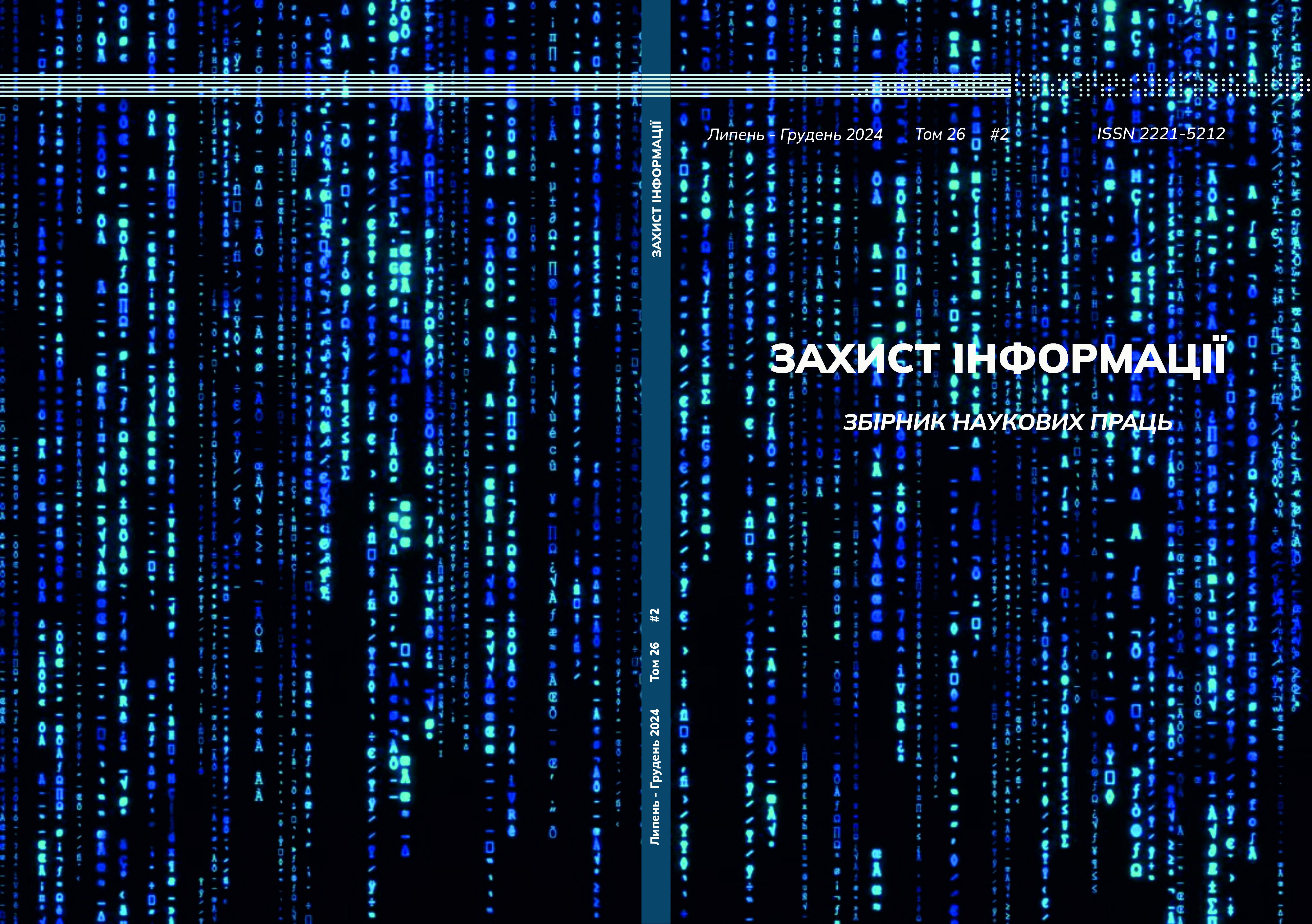МЕТОД ПОБУДОВИ ПРОФІЛЮ КЛЮЧОВИХ ФАКТОРІВ РИЗИКУ КІБЕРБЕЗПЕКИ СУЧАСНИХ РОЗПОДІЛЕНИХ ІНФОРМАЦІЙНИХ СИСТЕМ
DOI:
https://doi.org/10.18372/2410-7840.26.20014Ключові слова:
інформаційна безпека, ризик інформаційної безпеки, фактори ризику, оцінка ризиків, управління ризиками, розподілена інформаційна система, нейронна мережаАнотація
Оцінка та аналіз ризиків кібербезпеки є фундаментальними аспектами формування надійної і ефективної СУІБ, особливо в умовах стрімкого розвитку технологій та зростання складності сучасних РІС. Традиційні методи оцінки ризиків, що засновані переважно на концептуальних підходах і класичних методах, мають ряд обмежень та є малоефективними в умовах сучасних масштабованих розподілених систем, оскільки не враховують динаміку середовища та не забезпечують ефективний аналіз взаємозв’язків між численними факторами ризику. В дослідженні запропоновано метод побудови профілю ключових факторів ризику сучасних розподілених інформаційних систем на основі урахування кореляційного аналізу та моделювання їх взаємозв’язків, що дозволяє підвищити ефективність процесу оцінки ризиків кібербезпеки в умовах динамічного середовища сучасних масштабованих розподілених інформаційних систем. На основі запропонованого методу здійснено розробку профілю ключових факторів ризику сучасних розподілених систем, проведено аналіз їх статистичної важливості та кореляції, а також визначено і структуровано основні заходи та контролі інформаційної безпеки, які демонструють найкращі показники ефективності в умовах розподіленості середовища, враховують як технологічні, так і організаційні аспекти, забезпечуючи системний підхід до управління ризиками ІБ, зменшення впливу загроз і підвищення стійкості розподілених систем до можливих атак. Запропонований підхід до оптимізації вибору вхідного набору ознак та виокремлення найбільш вагомих факторів ризику на основі спроектованого профілю ключових факторів ризику для сучасних РІС продемонстрував тотожний результат по числовому показнику кількості відібраних для аналізу метрик у порівнянні з факторним аналізом за допомогою методу головних компонент (PCA) – 42 метрики у порівнянні із 40 для PCA, але при цьому забезпечив покращення загальних показників точності класифікації для проєктованих моделей оцінки ризику кібербезпеки в РІС на 4% у порівнянні з контрольною моделлю на основі PCA, що підтверджує його ефективність у контексті адаптивного аналізу ризиків у розподілених середовищах.
Посилання
Andrew S. Tanenbaum, Maarten Van Steen Distributed Systems: Principles and Paradigms, Prentice Hall of India; 2nd edition (January 1, 2007)
The State of Cybersecurity 2022 Report, Global Update on Workforce Efforts, Resources and Cyberoperations. ISACA [Електронний ресурс]. – Режим доступу до ресурсу: https://www.isaca.org/resources/reports/state-of-cybersecurity-2022.
Cybersecurity Assessment Report 2024. Bitdefender [Електронний ресурс]. – Режим доступу до ресурсу: https://www.bitdefender.com/content/dam/bitdefender/business/campaign/2024-Assessment-Report.pdf
Henry K. Risk management and analysis / Kevin Henry // Information Security Management Handbook / Edited by Harold F. Tipton, Micki Krauze. - 6th edition. - Boca Raton: Auerbach Publications, 2017. - Part 1, Section 1.4, Ch. 28. - P. 321-329.
Rot A. IT Risk Assessment: Quantitative and Qualitative Approach // Proceedings of the World Congress on Engineering and Computer Science, 2008. - p. 1073-1078.
Dmytro Palko, Vira Vialkova, Tetiana Babenko «Intellectual models for cyber security risk assessment» // Processing, transmission and security of information : Monografia. Tom 2. / Akademia Techniczno- Humanistyczna w Bielsku-Białej. –Bielsku-Biała : Wydawnictwo Naukowe Akademii Techniczno- Humanistycznej w Bielsku-Białej, 2019. – S. 284–288.
Chang, L.-Y. Applying fuzzy expert system to information security risk Assessment - A case study on an attendance system [Text] / L.-Y. Chang, Z.-J. Lee // 2013 International Conference on Fuzzy Theory and Its Applications (iFUZZY). - 2013. doi: 10.1109/ifuzzy.2013.6825462
Xin Y. et al. Machine learning and deep learning methods for cybersecurity //IEEE access. – 2018. – Vol. 6. – P. 35365-35381.
State of Enterprise Risk Management 2020 Survey // ISACA, CMMI Institute. - 2019. [Електронний ресурс]. – Режим доступу до ресурсу: https://www.isaca.org/-/media/info/state-of-enterprise-risk- management-survey/index.html
Dmitry Palko, Tetiana Babenko, Larysa Myrutenko, Andrii Bigdan «Model of information security critical incident risk assessment» // Proceedings of the 2020 IEEE International Conference «Problems of infocommunications. Science and technology» PIC S&T′2020, 6-9 October 2020, Kharkiv, Ukraine DOI: 10.1109/PICST51311.2020.9468107.
Johora, F. T., Khan, M. S. I., Kanon, E., Rony, M. A. T., Zubair, M., & Sarker, I. H. (2024). A Data-Driven Predictive Analysis on Cyber Security Threats with Key Risk Factors. arXiv preprint arXiv:2404.00068.
NIST Special Publication 800-30 Rev A. Risk Management Guide for Information Technology Systems, Gary Stoneburner, Alice Goguen, and Alexis Feringa, July 2002.
Palko D, Babenko T, Bigdan A, Kiktev N, Hutsol T, Kuboń M, Hnatiienko H, Tabor S, Gorbovy O, Borusiewicz A. Cyber Security Risk Modeling in Distributed Information Systems. Applied Sciences. 2023; 13(4):2393. https://doi.org/10.3390/app13042393
Dmytro Palko, Hrygorii Hnatienko, Tetiana Babenko, Andrii Bigdan «Determining Key Risks for Modern Distributed Information Systems» // IntSol-2021 Intelligent Solutions, September 28–30, 2021, Taras Shevchenko National University of Kyiv, Kyiv, Ukraine.
ISO/IEC 27001:2022. Information technology - Security techniques - Information security management systems - Requirements. 2022.
ISO/IEC 27002:2022. Information technology - Security techniques - Code of practice for information security controls. 2022
ISO/IEC 27005:2022. Information technology - Security techniques - Information security risk management. 2022.
Haykin S. Neural networks / S. Haykin. − W.: Williams, 2006. − 1104 p. – Режим доступу до ресурсу: https://cours.etsmtl.ca/sys843/REFS/Books/ebook_Haykin09.pdf.
Rassel S. Artificial Intelligence: Modern approach / S. Rassel, P. Norvig. − W.: Williams, 2005. − 1424 p. – Режим доступу до ресурсу: https://www.twirpx.com/file/1626837/.

##submission.downloads##
Опубліковано
Номер
Розділ
Ліцензія
Автори, які публікуються у цьому журналі, погоджуються з наступними умовами:- Автори залишають за собою право на авторство своєї роботи та передають журналу право першої публікації цієї роботи на умовах ліцензії Creative Commons Attribution License, котра дозволяє іншим особам вільно розповсюджувати опубліковану роботу з обов'язковим посиланням на авторів оригінальної роботи та першу публікацію роботи у цьому журналі.
- Автори мають право укладати самостійні додаткові угоди щодо неексклюзивного розповсюдження роботи у тому вигляді, в якому вона була опублікована цим журналом (наприклад, розміщувати роботу в електронному сховищі установи або публікувати у складі монографії), за умови збереження посилання на першу публікацію роботи у цьому журналі.
- Політика журналу дозволяє і заохочує розміщення авторами в мережі Інтернет (наприклад, у сховищах установ або на особистих веб-сайтах) рукопису роботи, як до подання цього рукопису до редакції, так і під час його редакційного опрацювання, оскільки це сприяє виникненню продуктивної наукової дискусії та позитивно позначається на оперативності та динаміці цитування опублікованої роботи (див. The Effect of Open Access).
